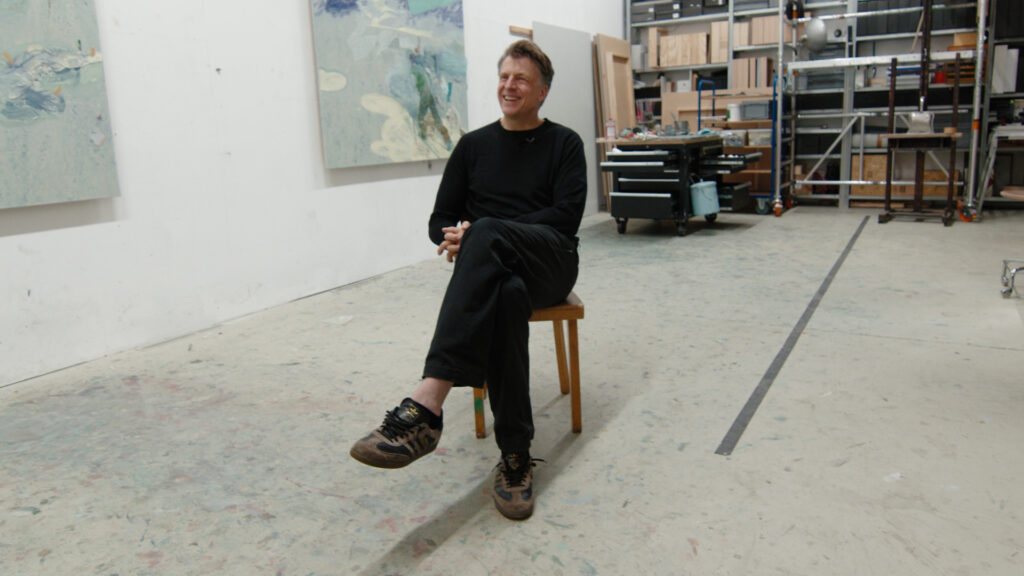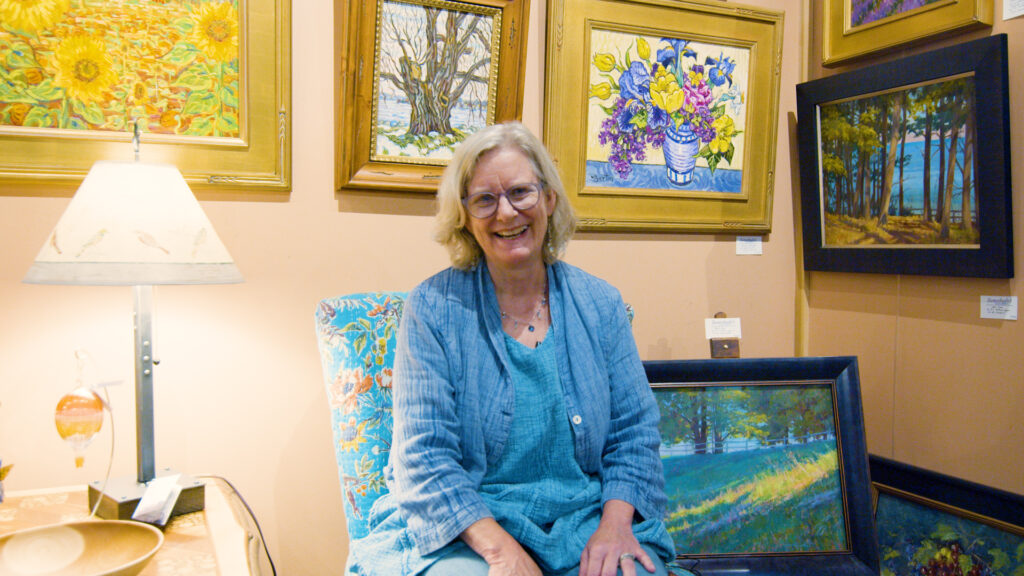In the heart of a bustling Bedford-Stuyvesant studio, we had the opportunity to meet Bones Gilmore, an artist whose creative journey is as compelling as his work. Instead of navigating the traditional art world, Gilmore has carved out a unique space for himself, blending a hands-on creative talent with a savvy, self-made approach to his career. He works primarily in drawing and painting, but his artistic path is defined by a fierce independence and a personal vision that sets him apart.
Gilmore’s studio pulsed with a vibrant energy, with his signature creations covering the walls. These weren’t just paintings on canvas; they were colorful, often whimsical, figures crafted onto MDF board and wood, giving each piece a tactile and tangible quality. As he spoke, it became clear that this work is a physical manifestation of his inner world—a deeply personal and spiritual journey he has been cultivating for years. The following is Gilmore’s story, told in his own words, detailing how his passion for art became a full-time profession.
Growing up, my artistic path was almost predestined. My dad is an artist, and my mom, who teaches preschool, incorporates a lot of arts and crafts into her curriculum. I was obsessed with drawing from a very young age, and my brother and I would draw together constantly. I even remember tracing Dragon Ball Z characters with my cousin when I was about four years old. That early obsession laid the groundwork for everything that came after. My artistic journey continued through school, where I focused more on painting, especially when I attended Bard College. Now, in New York, with limited space, I’ve returned to drawing, which has been a pivotal part of my current work.
The transition to a full-time artist happened unexpectedly. I had been working at a woodshop and was laid off for the winter with no other job prospects. Faced with the immediate need to pay rent, I decided to just start drawing and see if I could sell my work. What began as a temporary solution turned into a sustainable career. My goal now is simple: to make more work. I draw for at least half a day, every day, and I want to keep it that way. While I admit I want to be famous, the real motivation is to keep creating, to have my spiritual work seen and felt by others.

I’m Bones Gilmore. I’m from Massachusetts. I live in Bedford-Stuyvesant. I’m an artist.
How old are you?
26 years old.
And, like, seven months.
26.5.
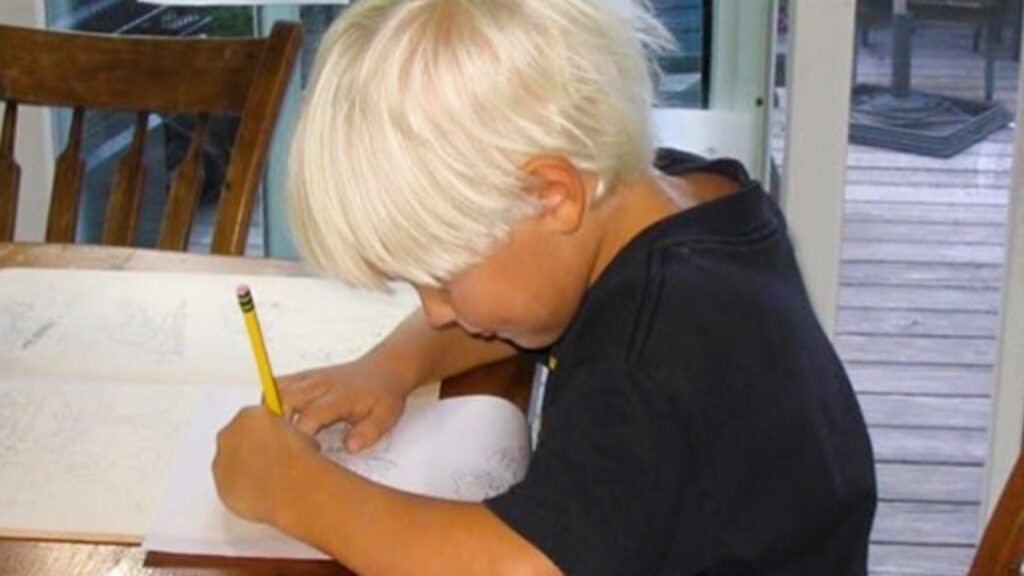
Why did you start doing what you’re doing now?
I could definitely answer that a couple of different ways. Before – at the beginning. At the very beginning.
Damn. I mean, yeah, my dad is an artist. My mom teaches preschool, like, little kids, and it’s arts and crafts. So when I was growing up, I was usually drawing. My brother drew with me a lot, too. And I’ve always been obsessive about drawing. I just draw a lot. You know, in school, I painted. I went to Bard College in upstate or like, not upstate, but, you know, in the Hudson Valley in New York and there I painted a lot more, I guess, like I’m in New York now. I have no space. This is my space. This is the studio. So I draw again where I’m at, like, right now. I got sort of laid off for the winter. I was working in a wood-shop. And, I had, like, no prospects for work. I was like, I’m going to just like, draw and try and sell it. And then it turned into like two months, like I paid rent one month and then two months, and then it’s just like, continued to go.
Yeah.
So you. So now you’re you’re doing it more as, like, a money thing.
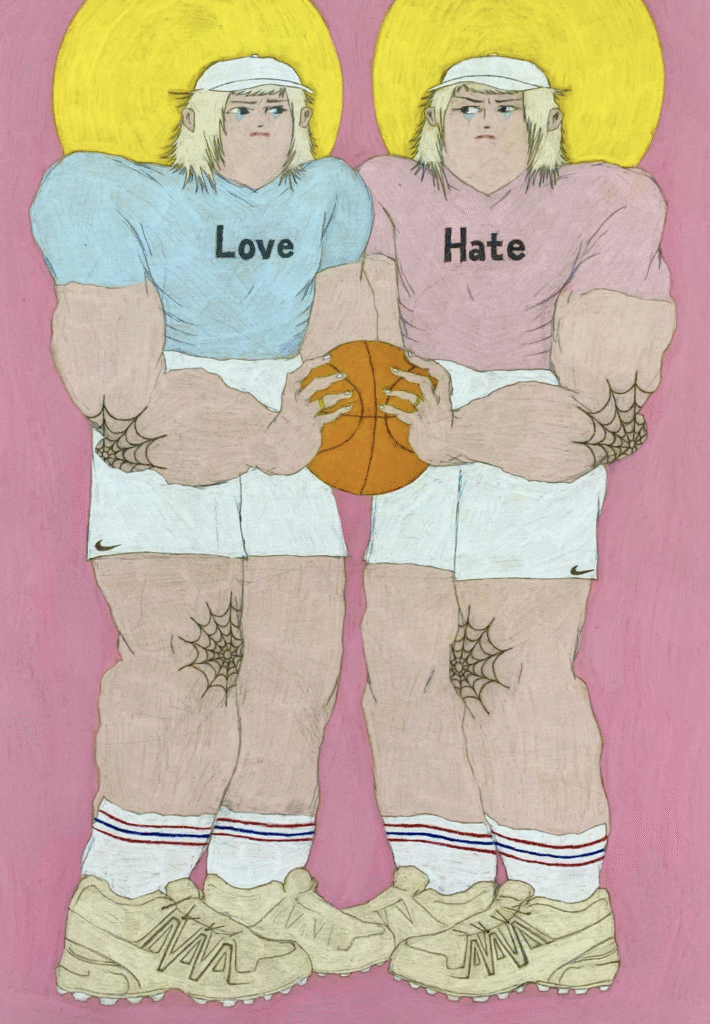
I really like making money from art. I don’t like making art for money; but one of my main drives is to keep making artwork without having to work a job.
– Bones Gilmore
When did you start making things, do you think, like, at what age?
Damn. I don’t know, like, I don’t know, like, what’s good with babies, like when you can start holding things. But it was like that. Like when I could I started to.
What types of things were you making? What is the earliest thing that you can remember making?
Making like, you know, like when you take, like, a potato, like a raw potato and, like, cut it into a shape and stamp it, I don’t know, that’s like, that comes to mind. My cousin, my cousin was, like, obsessed with Dragon Ball Z and had, like, binders full of, like, low resolution printed images of, like, Dragon Ball Z characters. And I would trace them with him. That’s like, if you look behind you, there’s like Goku drawing over and over that was like 2003 maybe. So I was like four. I don’t know.
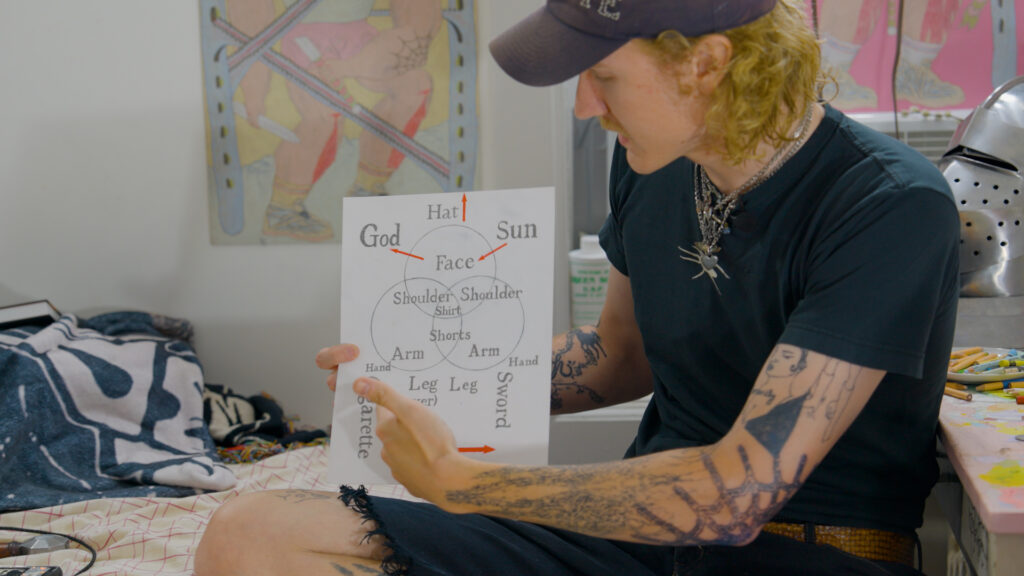
What do you think your goal is with what you’re doing? It can be small. It can be big. It could be both of those.
That’s like. That’s a good ass question. I was talking to someone about this earlier. Like, you know, the goal is just to, like, make more work. I think, you know, I want to right now, I pretty much draw every single day at least half the day. That’s kind of like how I want to stay, you know? Like, I want to also be famous to be, like, completely honest. But that’s what I was talking about with this friend. Like, what you know, what does it mean to, like, be famous? Like, what is the point? What are you going to get from it? You know, I think also, you know, my work is like, super, super personal, like, all of this is, like, very personal and, like, connected to sort of like my, like, spiritual life, you know, it’s like spiritual work and it’s like about my feelings pretty much. And half of them are self-portraits. And so it’s like, I don’t know, just like if, like, I feel better after I’ve made a piece, you know, and, like, sorted whatever out, for the day. And, I think people also just, like, really connect to it. So, like, I guess one of the goals is like having people see the work, you know,
How do you make the work? Like, how do you go about making a piece? What is your – you can give end-to-end process or you can give me like your thesis about how you make something either way or both, because I know you’re pretty meticulous based on how I can see everything built in here.
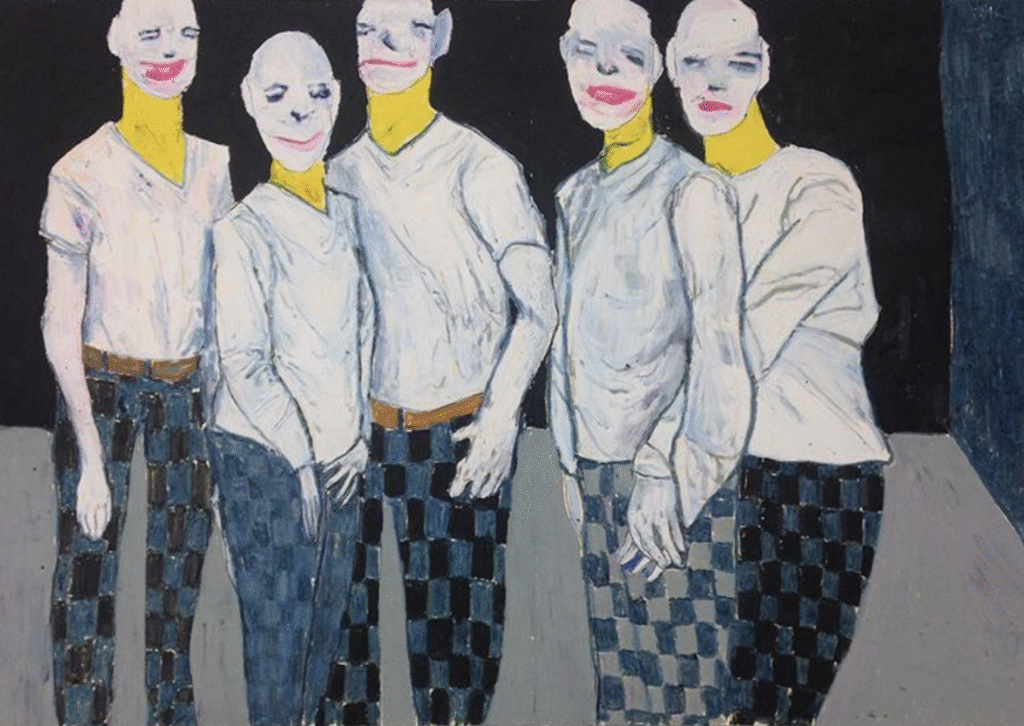
Yeah, totally. So I just got an another shipment of this stuff. I started drawing on this material. Like, because of that woodshop, I was getting it for free, and it’s nice to draw on. It’s like masonite. It’s called medium density fiberboard. It’s like dirt cheap. So I start with this – they’re like, pretty much all the same size. And I, like, really love drawing on it. Damn. I was making these diagrams that sort of explain, like, the process, you know, I like I’m kind of making the same image over and over. It’s just like something I latched on to, you know? Like, the character pretty much stays the same, like, across every single piece, but it’s sort of like props and then, like, information. So, like, you know, truth. It’s just that’s what it is, you know, that this piece is about truth. And, I don’t know, that’s about faith. Like, there’s like this, like, sort of like beam of fire. And then it’s like, that’s doubt. That’s what it is, you know? And then, like, this is like. You know, it’s like, that’s the body. You got the face, the shoulders, the shirt. This is how I draw it to, you know, I like I draw the face, usually with no plan. I draw the shoulders, I draw the shirt, I draw the arms. I put something like in the hands, usually a sword and a cigarette. It’s like almost the same every time. You know, it’s like all of the knees are bleeding, from praying on them a lot. Like, that’s like one of the motifs. I love shoes, so, like, all of – or like sneakers, not shoes. And so all of the characters, like, have both shoes visible, you know, it’s like. Yeah. And then, I mean, like, you know, sun on the face and then facing God kind of it’s like this, like formula and it’s just, I don’t know, I’m like running out of steam with it now, but, That’s sort of the process, you know, I like, draw the head on the board. I do the lines first, and then I color it in, you know, sometimes I, like, make the whole image and then I’ll, like, have, like, have this with, like, no text on it, and then I’ll like, spend like, I don’t know, a day, I’ll go for a walk and figure out what the drawing’s about, you know, and then I’ll put the text on so it means something. I don’t know. And then right once I finish something, I dust it off and photograph it, and then like, newer stuff just, like, goes up here. And then the oldest thing comes down and goes, like, back there with everything, And. Yeah, you know, I’m, like, putting together. The question was, how do I make stuff? Yeah. As far as, like a body of work goes because that’s what this is or that’s how I’m thinking of it. Like I’m putting together like 30 pieces for this show. And so that’s sort of everything new that I make is just like, informed by the other stuff going in the show. You know, that pile is like leftovers from a show I had in March, and it was the same deal, you know, like, everything was every every new thing I was making was based off of everything in that pile. You know, and, like, my style changes a lot. It’ll change again, like I made. I made that piece right there yesterday because I was, like, getting burnt out, on doing, I don’t know, like, they’re all kind of the same guy across, like. But, you know, he kind of just looks like that, you know, pink shirt, tan shorts with the white hair. So I don’t know.
What do you think? What do you think the work is about for you? What is your general thesis?
I think it’s sort of about like, faith. Faith in God in 2025. I’ve got this, like this triangle diagram that is sort of like how I think of the drawings, like I’m inspired by, like, God, medieval world and New York, you know, like, I’m trying to make something that’s pretty, like, timeless. And so that just ends up being medieval. I don’t know why, but that’s just like how it is. And then New York, because I’m here and that’s like what I see every day. And then, God, because that’s like what I’m thinking about all the time. And like, I’m not, you know, I have sort of like, really like personal, like a personal spiritual, like set of beliefs, you know, like, I’m not religious or like, I didn’t grow up religious. I don’t like associate with a religion or anything, but, you know, God’s sort of like the center of my life. And that’s pretty much what the work is about. I think of the characters as like they’re like monks or like angels.
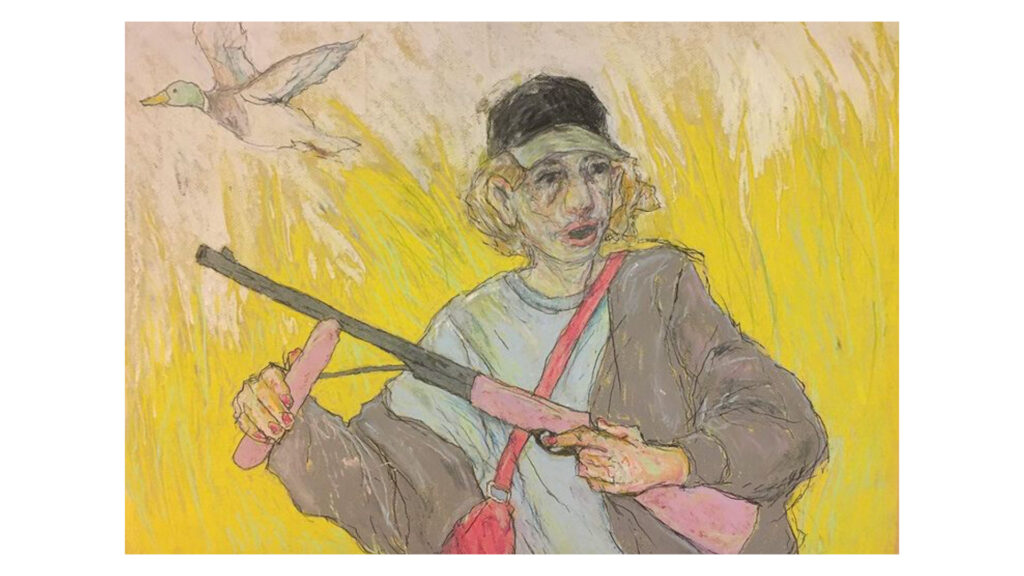
If you were to give advice to another artist, what would you say?
I’d say, like, be like, take care of yourself, I think is honestly, like the most important thing I found, like, sleep for eight hours. You know, if you’re feeling bad, talk to someone about it, like, feed yourself, you know, like, when I’m not, like, when I’m not feeling good or I’m feeling, like, in fear or angry. Like, I just don’t make good work, you know? Or like, I don’t know, like the other thing that I, I missed saying this earlier, but like, spiritual fitness is like the theme of all of these drawings. That’s why they’re like in like a little athletic wear is just like they’re spiritually fit and fitness in the sense of like, you know, like spiritually sound or like balanced. And so, like staying. Yeah. I don’t know, like, like keeping myself, like, spiritually taken care of. And, serene is like the goal, you know? And if that means, like, not drawing for a day, I will, or it’s like I need to go for a walk. I need to, like, talk to someone. I need to do my laundry because I can’t think about drawing. I think that’s my advice. And then also just, like, do it as much as you can, you know, like, recently, I guess, like, in the last two years, like, the word practice in art practice became like, I don’t know, it just like I didn’t think about it very much, but now I do. It’s like I literally have to practice. Like, I was just not as good at drawing as I was. Now six months ago, you know? And, part of that was like, you know, I have, I want to be the best I can be. I want to I already said I want to be famous. That’s like, not a very big motivator, but, actually, it is. It definitely is a big motivator. You know, I just like, I want to be good. And also, like, good art is what sells. And then I can, like, pay rent. It’s like it’s in my interest to, like, improve, you know, so I have to like, make time to practice, like, as much as I can, you know? And sometimes that means, like, you know, not hanging out with people or, like, going to bed early so I can wake up early or, I don’t know, you know, I think, like, discipline too, like, praying for more discipline, you know, like, if I’m an artist, I have, like, no structure in my life, you know, usually people have, like, a job, but my job is to sit down, like, right there and draw and make a piece. So I don’t know I don’t have any more questions. So that’s like that portion, but I kind of want to ask some guilty questions. Why? Color choice in the work. Color choice I think like I respond like really like. Negatively to just like certain like color combinations. Like the color is like. But I guess like also, you know, this this stuff has like it has like a value, you know, and these colors like, are close in value and they’re heavily pigmented. There’s some colors that if you put them on the wood, it just looks like trash, like it looks really bad. If the color is too dark, the wood comes through in the same way that like white paper would, and then it just looks crappy. But yeah, it’s just like the colored pencils I’m using, like a big, like, important part of, like, why these look the way they do is because, like, you can see the wood coming through them. So it’s like there’s, like, light and dark.

Do you think you could go back to painting?
I want to, I want to really bad. I would love to like, do these characters, like, big. You know, when I was painting, I have this, I made this book when I came to New York. I made it to, like, get money, but I was making, like, like, four foot by eight foot, sort of like abstract paintings. That was like my thing, you know, and I had, like, every intention to continue to make those when I came to New York.
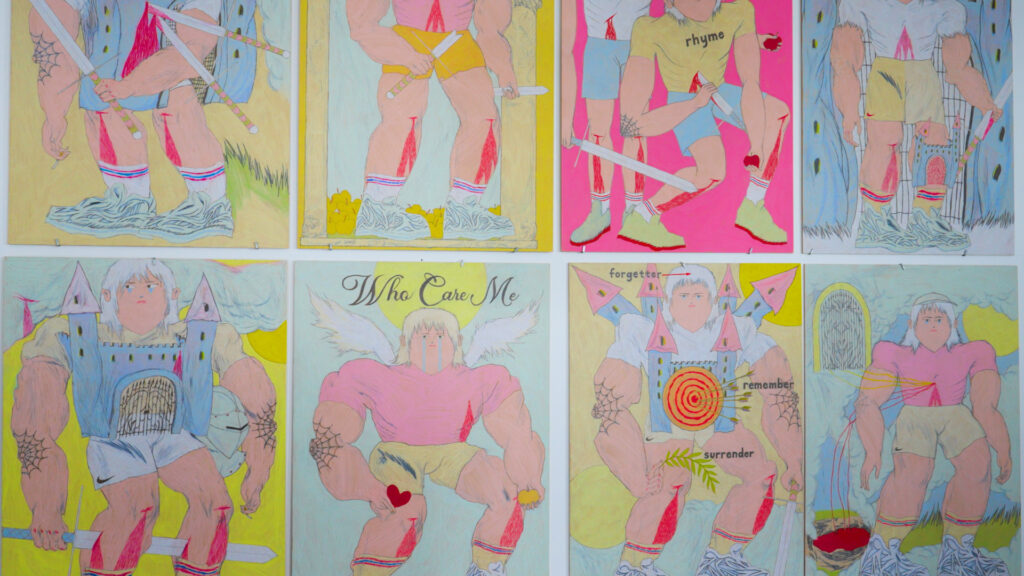
Well, where are they?
Those first, like, ten paintings are in my parents basement. And then most of the work in that is just, like, sold to people. I was selling work, for, like, very little money in college just to, like, have money, honestly, to buy drugs, to be straight up. And, I don’t know. I mean, I guess that’s like, that’s a huge part of, like, you know, all of the success I’ve found in, like, making work consistently and enjoying it is like not doing drugs or drinking. Like, being sober is one of the most important parts. I think.
What is something that you used to do in art that you don’t do anymore? Something that you’ve left behind?
That’s a good question. I don’t really know. Like. Certain motifs, certain things that I used to make. I used to I mean, I’ve always, like, done self-portraits. That’s like a big thing for me. And, I used to be drinking in the self-portraits, and. Now, I’m not. That was like a stark shift, you know, like my my thesis was like, about my alcoholism. So it was like about me drinking, like pretty much all of my work was about like either like my misery or drinking or both, you know, it was like, very like my, imagination was super narrow, you know? And now, like, I don’t I don’t make work from a place of suffering, you know, there’s like a lot of, like, symbolic suffering in it, you know, like, everyone’s bleeding is a big theme, but, you know, it’s like, not I’m not making it because, like, I’m, I’m suffering, you know, and I need to be like, look, I’m suffering, you know?
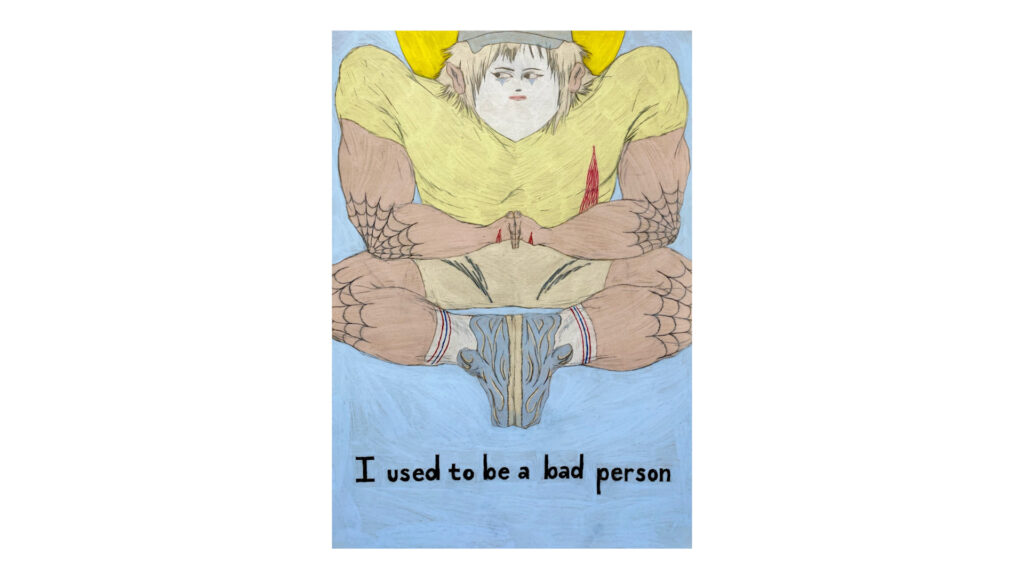
Do you think that you’re going to continue making these same types of work after the show is over?
I think there’s a pretty good chance I will be doing characters. I think that they’re going to just look different. You know, I like.
Where do you see yourself going next?
Something. You know, I like going back to the medieval theme, like the, the timeless medieval, you know, like knights and swords and shields. I’m like, super interested in medieval art and, in, like, illuminated manuscripts, but I don’t know anything about them. I don’t look at them like, I don’t I don’t engage with them at all when I make work. I just like, think about them as, like a, like a vibe, you know? So, I think, like doing, like, triptychs or, you know, like bigger pieces and also, you know, more like, maybe more realistic. You know, I was doing like, that’s a cartoon to me. And then these are anime because the faces got sharper, you know, and then like, next, I’ll maybe do, like, stuff that’s like realism, not like realism, like, but, you know, more like actual people looking characters.
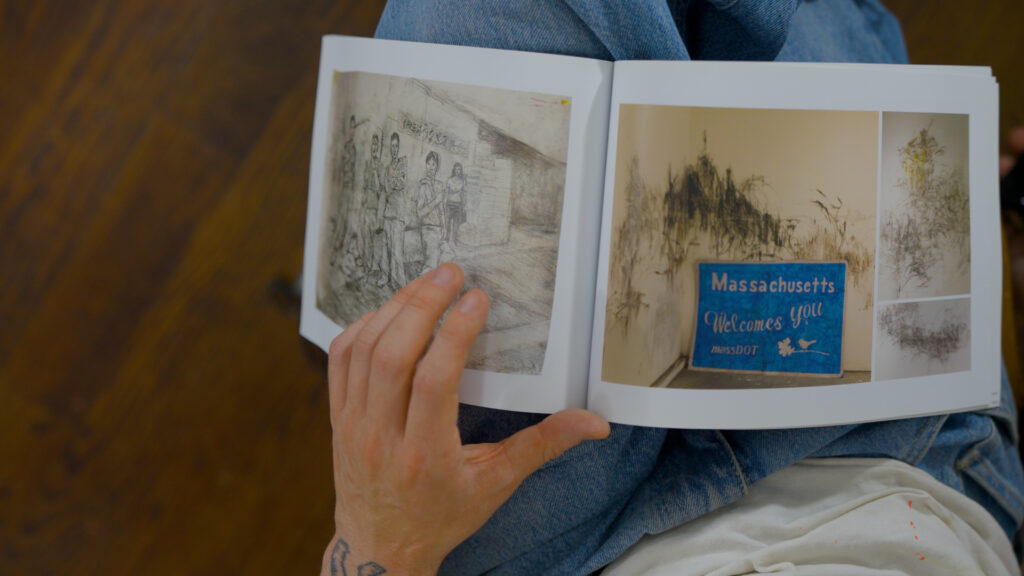
What are you most curious about right now?
I don’t even know. You know, I like, I made that drawing this morning, and I’m, like, pretty, just, like, bored of what I’m doing. I’m still, like, very motivated. I just don’t know what to do next. You know?
What was the question? What? What are you motivated to be? What motivates you right now? Oh, yeah.
I’m just motivated to figure out, like, what I’m going to make next. Yeah. You know, I want to like, there’s going to be a shift and I don’t know, like which direction or what it is every time. Like I get burnt out on a theme or style, I’m like, it’s fucking over. Like it’s over for me. And it’s like people only liked what I was making before, and that’s the only thing I can do. And then, I don’t know, you know, I’m working on, like, I’m developing faith in that, you know, because, it it works out and I change, and it, like, is good. But I don’t know, you know. So know, I think there’s good. Just for understanding. That’s for, you know, this is great. This work is fantastic. So in spite of you. Don’t get that if you like. Really? Yeah. Thank you. Well, I really appreciate it. Yeah. The works and I really enjoy it. Yeah, it looks really cool. Yeah. Please do. I’d love to come by and see me really quickly sometime to. Yeah. For sure. Yeah. Get some details. Yeah. Just go love that. That’s amazing. Yeah. Sharing this and are.
Sebastien Jupille
Sébastien Jupille’s story begins simply. As a kid he drew constantly, not because anyone pushed…
Eva Dixon
From the beginning, Eva Dixon’s relationship to making things was tied to the rhythms of…
Marc Sparfel
Marc Sparfel’s story begins with an act of discovery, the kind that happens quietly, without…
Ruprecht von Kaufmann
In his Berlin studio, Ruprecht von Kaufmann works surrounded by the quiet textures of linoleum,…
Amélie Caussade
Amélie’s journey as an artist began unexpectedly, born from a moment of sudden disruption. In…
Julie Stoppel
Julie Stoppel never planned to become an art teacher, or a gallery owner for that…




